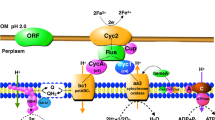Abstract
NATURAL oxidation of ferrous to ferric iron by bacteria such as Thiobacillus ferrooxidans or Gallionella ferruginea1, or by chemical oxidation2,3 has previously been thought always to involve molecular oxygen as the electron acceptor. Anoxic photochemical reactions4–6 or a photobiological process involving two photosystems7–9 have also been discussed as mechanisms of ferrous iron oxidation. The knowledge of such processes has implications that bear on our understanding of the origin of Precambrian banded iron formations10–14. The reducing power of ferrous iron increases dramatically at pH values higher than 2–3 owing to the formation of ferric hydroxy and oxyhydroxy compounds1,2,15 (Fig. 1). The standard redox potential of Fe3+/Fe2+ (E0 = +0.77 V) is relevant only under acidic conditions. At pH 7.0, the couples Fe(OH)3/Fe2+ (E′0 = -0.236V) or Fe(OH)3 + HCO−3FeCO3 (E′0 = +0.200 V) prevail, matching redox potentials measured in natural sediments9,16,17. It should thus be possible for Fe(n) around pH 7.0 to function as an electron donor for anoxygenic photosynthesis. The midpoint potential of the reaction centre in purple bacteria is around +0.45 V (ref. 18). Here we describe purple, non-sulphur bacteria that can indeed oxidize colourless Fe(u) to brown Fe(in) and reduce CO2 to cell material, implying that oxygen-independent biological iron oxidation was possible before the evolution of oxygenic photosynthesis.
Similar content being viewed by others
References
Wood, P. M. in Bacterial Energy Transduction (ed. Anthony, C.) 183–230 (Academic, London, 1988).
Stumm, W. & Morgan, J. J. Aquatic Chemistry 2nd ed (Wiley-lnterscience, New York, 1981).
Schwertmann, U. & Cornell, R. M. Iron Oxides in the Laboratory (VCH. Weinheim. 1991).
Cairns-Smith, A. G. Nature 276, 807–808 (1978).
Braterman, P. S., Cairns-Smith, A. G. & Sloper, R. W. Nature 303, 163–164 (1983).
François, L. M. Nature 320, 352–354 (1986).
Hartman, H. in Microbial Mats: Stromatolites (eds Cohen, Y., Castenholz, R. W. & Halvorson, H. O.) 449–453 (Liss, New York, 1984).
Walker, J. C. G. Nature 329, 710–711 (1987).
Cohen, Y. in Microbial Mats (eds Cohen. Y. & Rosenberg, E.) 22–36 (Am. Soc. Microbiol., Washington, 1990).
Schopf, J. W. A. Rev. Earth Planet. Sci. 3, 213–249 (1975).
Schidlowski, M. in The Early History of the Earth (ed. Windley, B. F.) 525–535 (Wiley, London, 1976).
Gole, M. J. & Klein, C. J. Geol. 89, 169–183 (1981).
Beukes, N. J. & Klein, C. in The Proterozoic Biosphere (eds Schopf, J. W. & Klein, C.) 147–158 (Cambridge Univ. Press, Cambridge, 1992).
Kasting, J. F., Holland, H. D. & Kump, L. R. in The Proterozoic Biosphere (eds Schopf, J, W. & Klein, C.) 159–163 (Cambridge Univ. Press, Cambridge, 1992).
Garrels, R. M. & Christ, C. L. Solutions, Minerals and Equilibria (Harper & Row, New York, 1965).
Mackenzie, F. T. & Wollast, R. in Global Chemical Cycles and their Alterations by Man (ed. Stumm, W.) 45–59 (Dahlem Konferenzen, Berlin, 1977).
Jørgensen, B. B. in Microbial Geochemistry (ed. Krumbein, W. E.) 91–124 (Blackwell, Oxford, 1983).
Dutton, P. L. & Prince, R. C. in The Photosynthetic Bacteria (eds Clayton, R. K. & Sistrom, W. R.) 525–570 (Plenum, New York, 1978).
Widdel, F. & Bak, F. in The Prokaryotes Vol. 4 (eds Balows, A., Trüper, H. G., Dworkin, M., Harder, W. & Schleifer, K.-H.) 3352–3378 (Springer. New York, 1992).
Pfennig, N. Int. J. syst. Bact. 28, 283–288 (1978).
Cohen, Y., Jørgensen, B. B., Revsbech, N. P. & Poplawski, R. Appl. environ. Microbiol 51, 398–407 (1986).
Pfennig, N. in Bergey's Manual of Systematic Bacteriology Vol. 3 (eds Staley, J. T., Bryant, M. P., Pfennig, N. & Holt, J. G.) 1650–1651 (Williams & Wilkins. Baltimore, 1989).
Lovley, D. R. Microbiol. Rev. 55, 259–287 (1991).
Nealson, K. H. & Myers, C. R. Appl. environ. Microbiol. 58, 439–443 (1992).
Stookey, L. L. Analyt. Chem. 42, 779–781 (1970).
Lovley, D. R. & Philipps, E. J. P. Appl. environ. Microbiol. 51, 683–689 (1986).
Lowry, O. H., Rosebrough, N. J., Farr, A. L. & Randall, R. J. J. biol. Chem. 193, 265–275 (1951).
Author information
Authors and Affiliations
Rights and permissions
About this article
Cite this article
Widdel, F., Schnell, S., Heising, S. et al. Ferrous iron oxidation by anoxygenic phototrophic bacteria. Nature 362, 834–836 (1993). https://doi.org/10.1038/362834a0
Received:
Accepted:
Issue Date:
DOI: https://doi.org/10.1038/362834a0
- Springer Nature Limited
This article is cited by
-
Current analysis of cations substitution in the oxygen-evolving complex of photosystem II
Biophysical Reviews (2024)
-
High-efficiency oxygen evolution by photosystem II oxygen-evolving complex containing 3Mn per reaction center
JBIC Journal of Biological Inorganic Chemistry (2023)





